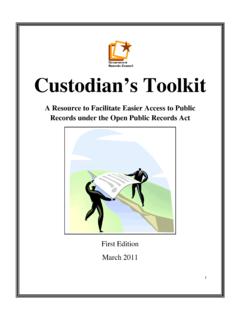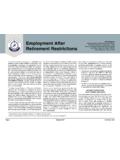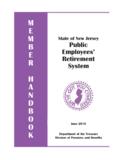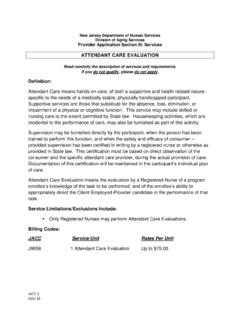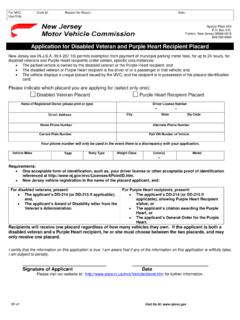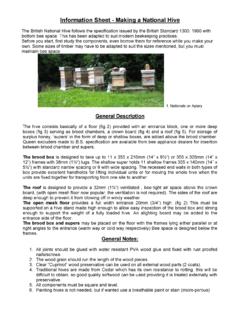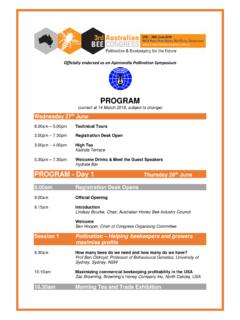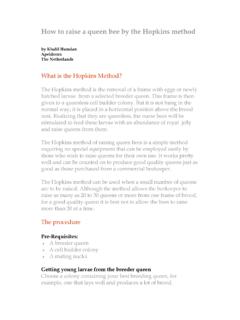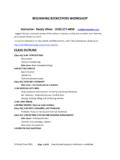Transcription of A Field Guide to Honey Bees - New Jersey
1 A Field Guide to Honey bees and Their MaladiesThe Mid-Atlantic Apiculture Research and Extension Consortium (MAAREC): Delaware, Maryland, New Jersey , Pennsylvania, West Virginia, Virginia, and the USDA cooperatingCollege of Agricultural SciencesM. FRAZIER, PENN PHOTO: M. FRAZIER, PENN STATEI ntroductionThe key to protecting Honey bee colonies from diseases, parasites, and other harm-ful conditions is the ability to identify and deal with problems early. This publication is designed to assist beekeepers in recog-nizing the symptoms of common Honey bee maladies. Some simple cultural controls are included here; however, for a complete list and discussion of manage-ment tactics and currently registered chemicals approved for the control of Honey bee maladies, see the MAAREC Web site, FRAZIER, PENN STATEA Field Guide to Honey bees And tHeir MAlAdies 2 Normal Honey Bee DevelopmentThe Honey BeeA healthy Honey bee colony has three distinct types of individuals: a queen, workers, and drones.
2 Each type of bee has a distinct role in the colony. Collectively, they make up the members of a Honey bee Honey beeThe queen is critical to the survival of the colony. Usu-ally, she is the only actively reproductive female and lays all the eggs in the colony. Normally, only one queen is present in each colony, and she is the mother of all the individuals in that Honey beesThe workers also are female but have undeveloped ova-ries, so they normally do not lay eggs. They perform all of the work in the colony, including caring for the brood, building the comb, tending to the queen, gathering resources (nectar, pollen, resins, water), and defending the hive. The tasks workers perform change as they age and are influenced by the particular needs of the colony at a given time. A colony may contain 20,000 to 60,000 workers, depending on its age and the time of year.
3 Normal Honey Bee DevelopmeNt 3M. FRAZIER, PENN STATEM. FRAZIER, PENN STATEM. FRAZIER, PENN STATEM. FRAZIER, PENN STATEA Field Guide to Honey bees And tHeir MAlAdies 4 Drone Honey beesMale Honey bees are known as drones. Their only task is to mate with virgin queens, usually from colonies other than their own. They are larger than workers and are identified easily by their large, contiguous (touch-ing each other) eyes. Mature drones leave colonies in the early afternoon and fly to drone congregation areas found 40 feet above the ground. Here drones in flight wait for a virgin queen on a mating flight. If successful mating takes place, the drone dies immediately after mating. Colonies may contain none, a few, or several hundred drones, depending on the strength of the colony and the time of year. In the fall or after an abrupt end to a Honey flow, workers force drones out of the colony.
4 They may also remove any developing drone brood from the colony, which can pile up at the colony entrance. Stages of developmentHoney bees develop through a process called complete metamorphosis. Like butterflies, bees begin life as an egg, then enter the larvae stage before spinning a co-coon, pupating, and later emerging as adult bees . Unlike butterflies, bees complete all these stages in one place, a single cell of the beeswax queen lays eggs one to a cell. Each egg is attached to the cell bottom and looks like a tiny grain of rice. When first laid, the egg stands straight up. Over the three days it takes the eggs to hatch, they slowly bend so they lie flat on the bottom of the cell. The egg coat then dissolves, resulting in a tiny, C-shaped larva. Normal Honey Bee DevelopmeNt 5M. FRAZIER, PENN STATEM.
5 FRAZIER, PENN STATEM. FRAZIER, PENN STATEA Field Guide to Honey bees And tHeir MAlAdies 6 LarvaeHealthy worker, queen, and drone larvae are pearly white in color with a glistening appearance. When young they are curled in a characteristic C shape on the bottom of the cell and continue to grow during the larval period, eventually filling their cell. In all insects, including bees , the larval stage is the growth stage. Worker bees feed large amounts of food to the developing larvae to ac-commodate this tremendous larval bees are fully grown, they stretch out length-wise in their cells, which are then capped by workers. At this stage they are prepupae and remain pearly white, plump, and glistening. The prepupae then spin a cocoon before entering the true papal the pupal stage the bee undergoes tremen-dous change.
6 After two days, healthy prepupae begin to change from their larval form into the pupal form; healthy pupae remain white and glistening during the initial stages even as their bodies begin to take on the adult form. The compound eyes are the first areas to change color, from white, to pink to purple, and finally to brown. After the eyes darken, the rest of the body begins to darken, taking on the color and features of an adult bee. These changes all occur within the capped cells. Normal Honey Bee DevelopmeNt 7S. CAMAZINEM. FRAZIER, PENN STATEM. FRAZIER, PENN STATEA Field Guide to Honey bees And tHeir MAlAdies 8 CaPPeD brooDHealthy developing worker and drone cells are capped after larvae are approximately and days old, respectively. A healthy worker brood pattern is easy to recognize: brood cappings are medium brown in color, convex, and without punctures.
7 Healthy capped worker brood normally appears as a solid pattern of cells with only a few uncapped, or open, aDuLt Worker beeNew queens, workers, and drones emerge approximately , 12, and days, respectively, after their cells were capped. Individually they must chew through the wax cap covering the beeswax cell in which they developed. They assume normal adult duties almost bees to CaPPeD brooDThe ratio of adult bees to capped brood cells is typically two adult bees to one capped brood cell. This ratio is affected by the season. In the spring colonies may suffer from spring dwindle, where the adult population is lost at a rate faster than brood can emerge to replace them. In the fall as brood rearing slows the ratio may be higher. Normal Honey Bee DevelopmeNt 9M. FRAZIER, PENN STATEM. FRAZIER, PENN STATEM.
8 FRAZIER, PENN STATEA Field Guide to Honey bees And tHeir MAlAdies 10 Types of cellsheaLthy brooD frameA brood frame from a healthy colony typically has bands of cells with different contents, including capped and uncapped Honey , stored pollen (called bee bread), eggs, uncapped brood, and capped brood. CaPPeD honeyWhen bees have ripened their Honey , they cap the cells with wax. Different bees cap cells differently; some leave a small pocket of air between the wax capping and Honey , giving the capping a snowy white color, while other bees place the wax capping directly on the Honey , making the capping look dark. In cases where brood was previously reared, the Honey may look dark compared to the Honey in surrounding cells. There is no difference in the quality of Honey below these breaDBees collect and store pollen, which is used as a protein source for the developing larvae.
9 The pollen is transport-ed to the hive as compact pellets in the pollen baskets on the bees hind legs and placed in storage cells around the brood nest. bees process the pollen by compress-ing the pollen pellets in the cells, which is followed by a lactic acid fermentation, and finally covering them with a thin film of nectar. Normal Honey Bee DevelopmeNt 11M. FRAZIER, PENN STATEM. FRAZIER, PENN STATEM. FRAZIER, PENN STATEA Field Guide to Honey bees And tHeir MAlAdies 12 Queen CeLLsQueen cells differ from all the other cells in the colony in that they are much larger and hang down vertically rather than being horizontally positioned. There are three different types of queen cells: swarm cells, super-sedure cells, and emergency replacement cells. swarm cells Swarm cells are typically found in very strong colonies in spring and occasionally in the late summer/early fall.
10 They are usually found along the edges of the brood nest in large numbers. Swarming is the process by which Honey bee colonies reproduce. Once the new swarm cells are capped, the mother queen and ap-proximately half of the colony s population will leave in search of a new nesting site. If managing colonies for Honey production, this is not desirable because it reduces Honey production. Upon finding swarm cells beekeepers usually remove them and provide the colony with additional space. supersedure cells Supersedure cells are reared by colonies attempting to replace their aging or damaged queen. There are usually only a few of these cells, which can be found either in the middle or along the edges of brood frames. If it is possible to get a mated queen, consider removing these cells and the mother queen and replacing her with a new, mated queen.
